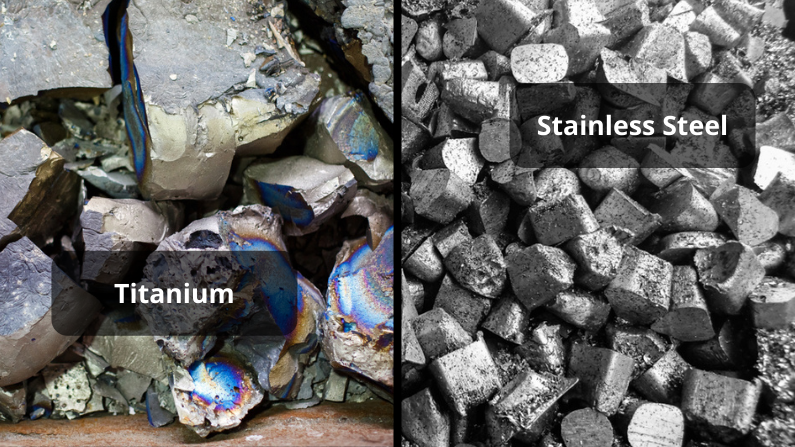In industries where strength, weight, and corrosion resistance are critical, two materials consistently come into focus—titanium and stainless steel. Both are widely used in high-performance applications like aerospace, medical devices, marine components, and advanced manufacturing.
While stainless steel is well-known for its durability and affordability, titanium is often chosen for its incredible strength-to-weight ratio and corrosion resistance. But which one truly offers more value for your specific application?
In this blog, we’ll compare titanium and stainless steel based on key performance factors such as strength, weight, corrosion resistance, cost, heat resistance, biocompatibility, and more to help you make a better material choice.
Titanium vs. Stainless Steel
Strength and Weight
Titanium is famous for its high strength-to-weight ratio. It offers excellent mechanical strength while being significantly lighter than stainless steel. This makes it ideal for applications where reducing weight is critical without compromising on strength—such as aircraft parts, high-performance vehicles, or sporting equipment.
Stainless steel, while strong, is nearly 60% heavier than titanium. Though it offers good tensile strength, the added weight can be a disadvantage in mobile or structural applications where every gram matters.
Verdict: Titanium wins in strength-to-weight performance. Stainless steel is heavier but still strong and more cost-efficient.
Corrosion Resistance
Titanium has outstanding corrosion resistance. It forms a thin, stable oxide layer on its surface that protects it from rust, saltwater, and most chemical attacks. It is nearly immune to corrosion even in harsh environments like marine, chemical, or acidic settings.
Stainless steel also offers good corrosion resistance, particularly grades like 304 or 316, but it can still corrode in certain chloride-rich or acidic conditions if not properly maintained.
Verdict: Titanium provides superior corrosion resistance and is the preferred material in harsh, wet, or chemical environments.
Cost Comparison
One of the major drawbacks of titanium is its high cost. The material itself is expensive, and the processing and machining of titanium are more complex and time-consuming. This makes titanium cost-prohibitive for general applications.
Stainless steel is more budget-friendly, widely available, and easier to work with, making it a cost-effective choice for most industrial and commercial uses.
Verdict: Stainless steel wins in affordability and practicality for everyday applications.
Heat Resistance
Titanium has a high melting point (about 1668°C) and retains strength even at elevated temperatures, making it suitable for aerospace, engines, and other high-heat scenarios.
Stainless steel also performs well under heat, especially high-temperature grades like 310 or 321, but it starts to lose strength at lower temperatures compared to titanium.
Verdict: Titanium handles extreme heat better, but stainless steel is still suitable for many elevated-temperature applications.
Biocompatibility
Titanium is biocompatible, non-toxic, and non-reactive with human tissue, which is why it’s commonly used in medical implants, dental hardware, and surgical tools. The human body does not reject titanium, and it integrates well with bone and skin.
Though certain stainless steel grades are used in medical devices, they may cause allergic reactions or corrosion in the long term if not carefully chosen or treated.
Verdict: Titanium is the clear winner for medical and implant applications due to its unmatched biocompatibility.
Machinability and Fabrication
Titanium is difficult to machine and form. It requires specialized tools, slower speeds, and advanced processes to prevent galling or overheating. Welding titanium also demands a highly controlled environment to avoid contamination.
Stainless steel is easier to fabricate, cut, weld, and form. It’s more forgiving in standard manufacturing environments and does not require as many precautions during processing.
Verdict: Stainless steel is easier and cheaper to machine and fabricate.
Magnetic Properties
Titanium is non-magnetic, which makes it ideal in sensitive environments such as MRI machines, electronic devices, or defense applications where magnetism must be avoided.
Stainless steel can be magnetic or non-magnetic, depending on the grade. For example, ferritic and martensitic steels are magnetic, while austenitic stainless steels (e.g., 304 and 316) are mostly non-magnetic.
Verdict: Titanium is naturally non-magnetic, which may be beneficial in specialized applications.
Comparison Table: Titanium vs. Stainless Steel
| Property | Titanium | Stainless Steel |
|---|---|---|
| Strength-to-Weight Ratio | Very high, excellent for performance applications | Good, but heavier |
| Corrosion Resistance | Superior, even in saltwater or acid | Good, but can corrode in harsh environments |
| Weight | Lightweight | Heavier |
| Cost | Expensive to produce and process | More affordable and widely available |
| Heat Resistance | Excellent, high melting point | Good, but lower heat tolerance |
| Biocompatibility | Excellent, ideal for implants | Moderate, may cause reactions in some cases |
| Fabrication | Difficult to machine and weld | Easier to work with using standard tools |
| Magnetic Properties | Non-magnetic | Depends on the grade |
Conclusion
Titanium and stainless steel are both exceptional materials, each offering unique advantages depending on the application.
If your priority is maximum performance, lightweight design, superior corrosion resistance, or biocompatibility, titanium is the ideal material—especially in aerospace, medical, and marine settings. However, these benefits come at a significantly higher cost.
For applications that require good durability, resistance to wear and corrosion, and cost-efficiency, stainless steel remains the go-to choice. It offers a solid balance of strength, affordability, and ease of manufacturing.
Ultimately, your material decision should align with your performance needs, budget, and operational environment. Weigh the pros and cons based on these factors to make the best investment in your project’s success.



